Today, LinkedIn stands out as a dynamic hub for B2B connections where your words can make waves and resonate with the people who matter in your industry and can become your potential clients.
With 930 million users worldwide, many of those being high-earning B2B professionals, LinkedIn is a prime source for marketers looking for prospective paying customers. It’s home to 65 million decision-makers, making it a top-rated network for lead generation.
In this piece, we’ll cover 11 solid LinkedIn lead generation strategies — from optimizing your profile to mastering the art of email extraction, from crafting magnetic content to leveraging targeted ads.
Each strategy comes packed with practical tips that go beyond the surface. So whether you’re a budding entrepreneur, a rising star in sales, or a marketer looking to up your career, these strategies are your guidebook to navigate LinkedIn lead generation smoothly and effectively.
Outline
The LinkedIn lead generation trifecta: Content, Outreach, and Ads
Sometimes, navigating LinkedIn lead generation tools can feel like conducting an orchestra—you should have a keen sense of timing, a dash of creativity, and the right mix of instruments. Our digital symphony relies on three main instruments: content, outreach, and ads.
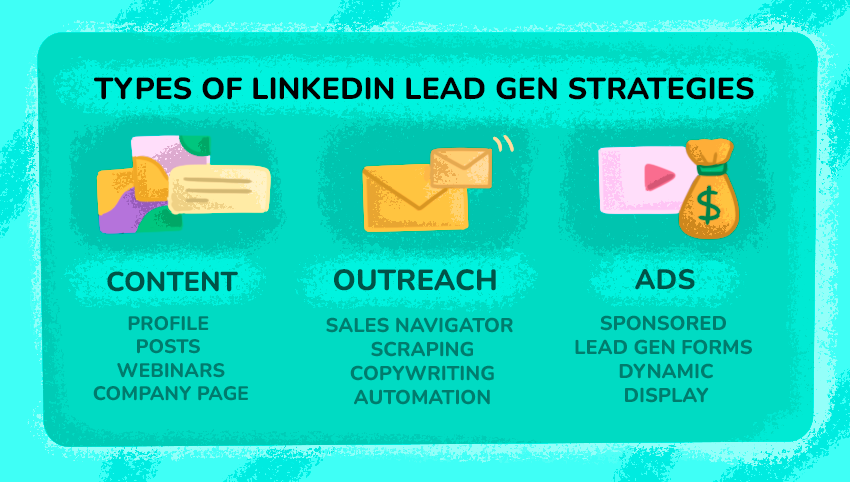
Let’s try to understand how to make these LinkedIn lead generation strategies play in sweet harmony.
#1. Content—Your digital handshake
Your LinkedIn profile is a living, breathing resume. It’s not just a place to brag about your accomplishments (though we know you’ve got plenty to boast about!).
Engage your audience with valuable content that says, “Hey, let’s talk business.” Whether through insightful posts showcasing your expertise, webinars proving you’re a thought leader or a well-curated company page, your content should be irresistibly “share-worthy.”
#2. Outreach—The art of the (not so) cold call
If Content is your handshake, then Outreach is the follow-up coffee date where you seal the deal. Tools such as Sales Navigator and email finders are like GPS for navigating potential leads.
It’s about personalization, not just automation. You’re not a robot scraping data – the goal here is to start meaningful conversations.

#3. Ads—The billboard on the highway
Ads are bold, they’re bright, and if done right, they make you want to take the next exit. With tools like Sponsored Content and LinkedIn Lead Gen Forms, you’re not throwing darts in the dark. You’re targeting with the precision that complements your content and outreach efforts.
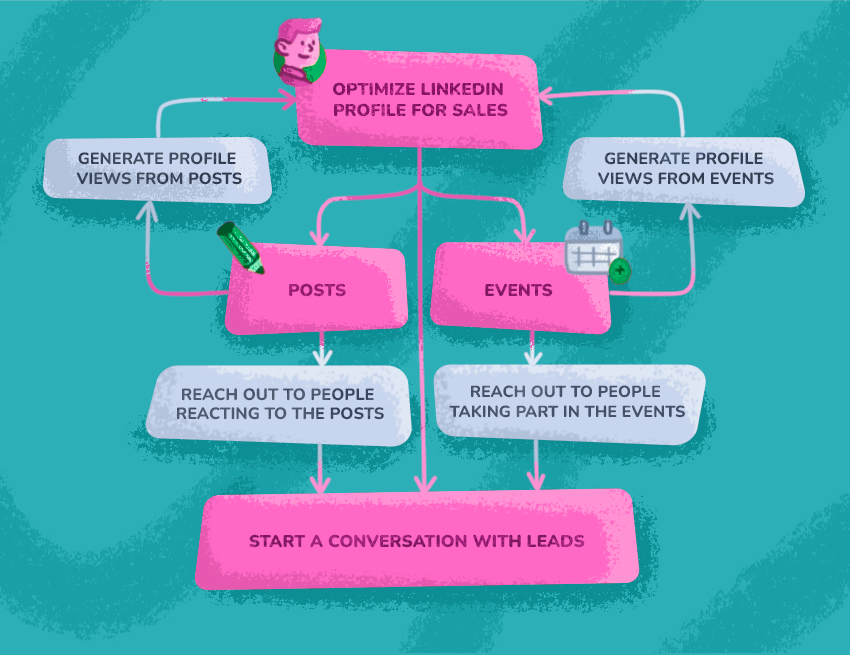
So, there’s the fundamental three-pronged strategy for LinkedIn lead generation. It’s about blending the personal touch with the power of technology. Too much automation and you’re just another bot. Too little, and you’re shouting into the void.
All you need is to find your balance.
LinkedIn lead generation strategies you can’t miss but can mix
1. LinkedIn profile optimization
You’ve heard it before: a professional, complete LinkedIn profile is the first impression you make when you ping that connection request. Would you trust a business with a lackluster website? Probably not. The same goes for your LinkedIn page. It’s your online sales pitch, and it’s got to be sharp.
But what exactly should you do to meet these criteria? Here are some practical tips:
- Profile picture: Forget about selfies. Choose a professional photo that shows you mean business. It’s like the friendly nod across the room before a meeting.
- Headline: More than just your job title, your headline should be a mini-pitch. It’s the hook that gets people curious. Make it clear, compelling, and specific to your expertise.
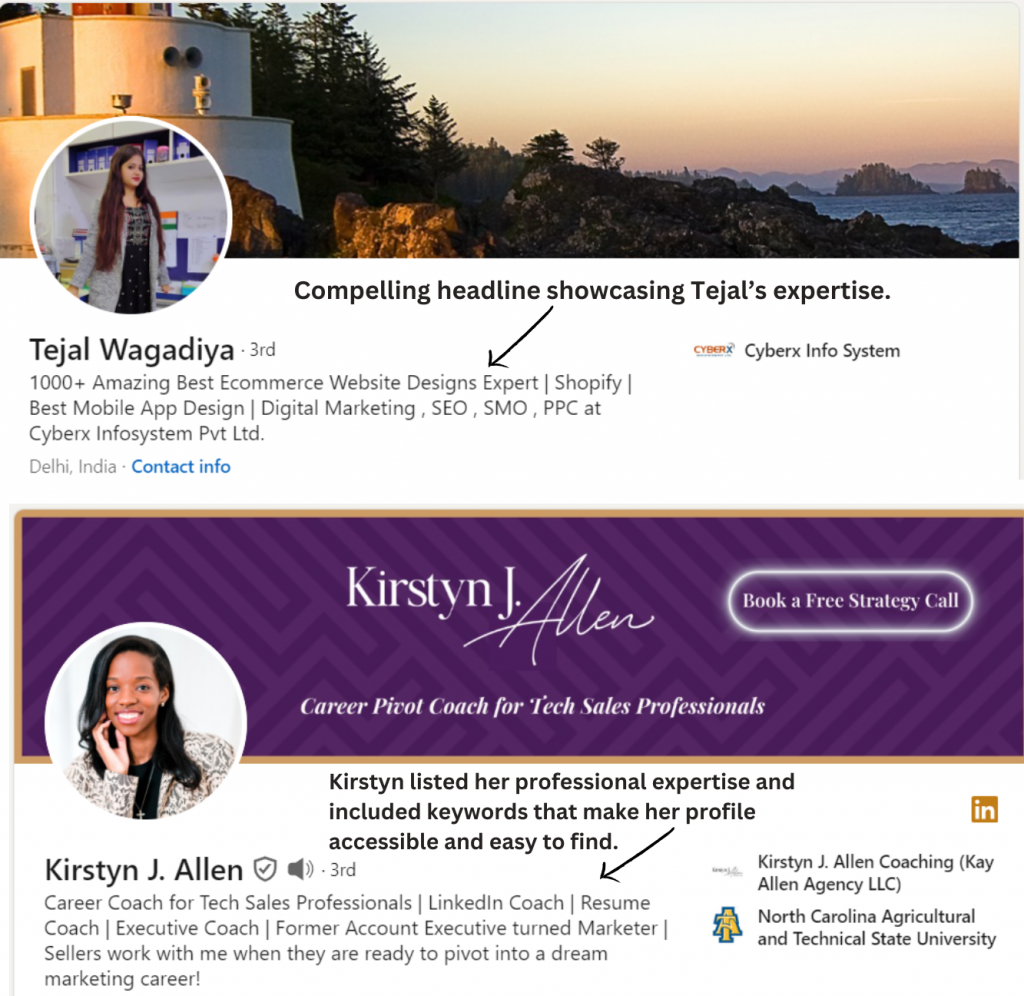
- Banner image: Your banner is prime real estate for showing off your value proposition. Use this space to visually communicate what you do and who you help.
- About section: This is where you tell your story, but not your autobiography. Focus on your value proposition. Keep it concise but impactful. What problems do you solve? How do you make your clients’ lives easier? Go beyond listing job titles. Detail how each role contributed to your skill set and the value you bring.
- Best posts: Pin your top posts to your profile. Choose content that highlights your expertise and the solutions you offer. It’s like a mini-portfolio of your best hits.
Remember, optimizing your profile is the foundation of your LinkedIn lead generation efforts. Skip this step, and all other strategies lose their edge. A well-crafted profile doesn’t just open doors; it invites your prospects in for a meaningful conversation.
2. Content creation and sharing
Produce relevant content. Be it blog articles, social media posts, or videos, you should always address the pain points and interests of your target audience. Share tips, industry insights, or stories about your business journey—make it relatable and substantive.
Tips on sharing engaging content
It’s not just WHAT you share but HOW you do it. Ask questions, encourage feedback, and engage with those who interact with your posts. Be consistent but not overwhelming. Consider creating a regular posting schedule that keeps you on the radar without overloading your followers.
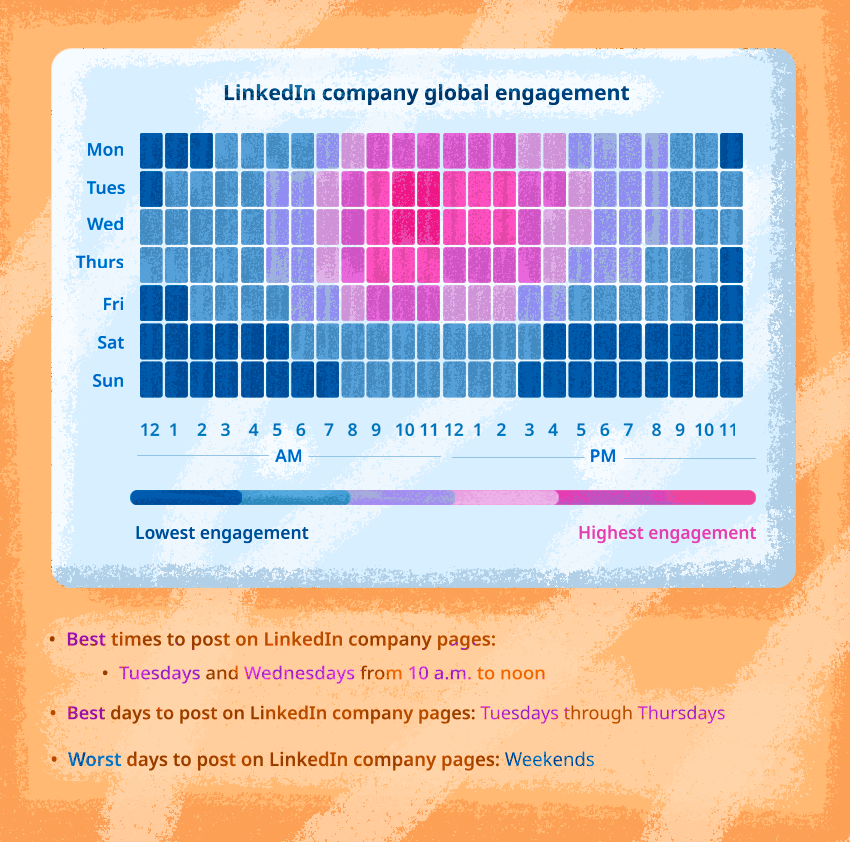
Types of content to consider
- Tell a Story: Everyone loves a good story. Share a recent challenge you overcame or a successful case study. It humanizes your brand and makes you more relatable.
- How To’s: Share tutorials or step-by-step guides relevant to your industry. It shows your expertise and willingness to help others.
- Interactive Content: Engage your audience by offering something valuable, like a white paper, in exchange for comments on your posts. It’s a great way to spark interaction.
By focusing on creating and sharing content that adds value, you position your brand and yourself as an authority in your field.
3. LinkedIn groups
On top of being busy discussion forums, LinkedIn groups are also targeted communities where you can connect with peers, industry leaders, business partners, and, of course, potential clients. They offer a rich platform for you to demonstrate your expertise.
Choose the right groups
Select groups that align with your industry, interests, or target market. For instance, if you’re in B2B marketing, join groups like “B2B Marketing Professionals” or “Content Marketing Institute,” where discussions are more likely to be relevant to your field.

Engage to build authority
Rather than just observing, dive into discussions. Here are some practical ways to engage:
- Initiate conversations that encourage engagement. You can post a thought-provoking question or conduct a poll on a current industry trend. For instance, a question like “What do you think will be the biggest challenge for digital marketers in 2024?” can spark meaningful conversations and draw attention to your expertise.
- Respond to questions. If someone asks for advice or information that falls under your expertise, offer thoughtful and informative answers. This shows your willingness to help and your depth of knowledge.
- Contribute unique insights. Share your own experiences or case studies. If you’ve recently succeeded with a new marketing strategy, describe your approach and results. Offer real-world examples that others can learn from.
- Share relevant articles. Post articles or studies pertinent to the group’s focus. For example, if a new marketing trend is emerging, share an article about it and ask the group for their opinions or experiences.
You’ll naturally build a reputation as a knowledgeable and helpful group member as you consistently provide valuable input. This recognition is crucial for establishing trust and opening up networking opportunities that could lead to potential business relationships.
4. Getting lead emails from LinkedIn
You might ask, “Can’t I just send connection requests and communicate with prospects directly on the platform?” Sure, it’s the easiest way, and it’s completely free.
But you need to consider that no more than 100 invitations to connect per week are safe to send without putting your account at stake.
The way out? Move the conversation outside LinkedIn!
Extracting viable contact information from the professional network can be a challenging but necessary step in generating quality leads on LinkedIn. Email finder tools like Snov.io, Reply.io, Expandi, and many others are invaluable for seamlessly transitioning from identifying potential leads to initiating direct communication.
How to find leads on LinkedIn
First, use LinkedIn search to find potential leads tailored to your business needs based on specific filters, such as position, location, and industry. Then, extract their email addresses using Snov.io or other software. Now, you can start creating personalized email campaigns! It’s that easy.
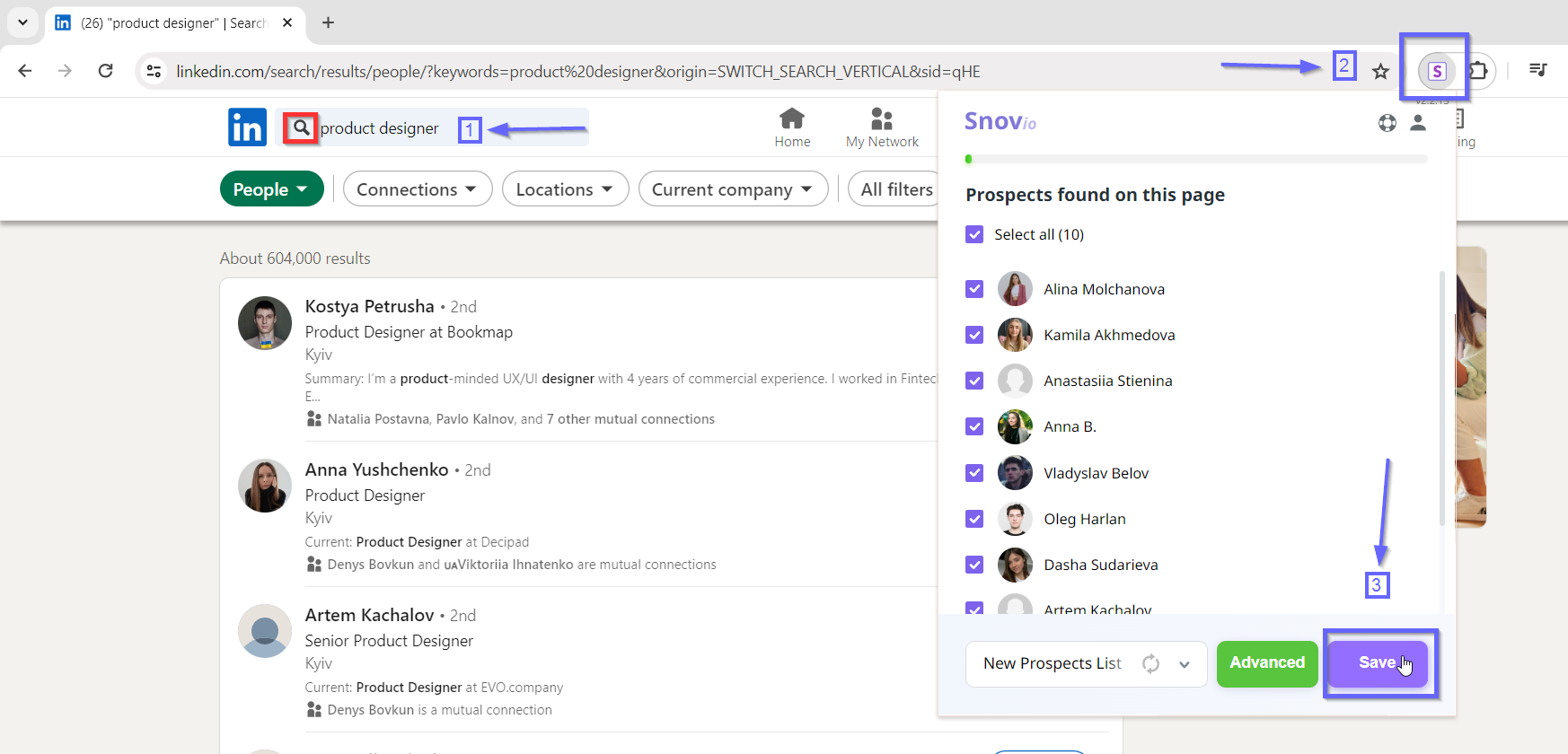
The Snov.io LI Prospect Finder tool contains a mixture of features that streamline the process of converting LinkedIn connections into actionable leads. It works in harmony with LinkedIn, allowing you to easily collect prospects’ emails from search, personal, and company profile pages.
It’s also worth noting that Snov.io goes a step further by verifying the emails it finds. Your outreach efforts will be focused on valid, active email addresses, increasing the success rate of your email campaigns. It’s a dream come true for a campaign manager!
With verified emails, you can transition from LinkedIn’s platform to direct email outreach, creating personalized messages for potential customers. Also, you can export entire prospect lists to XLS, CSV, and Google Sheets.
5. Advanced Search with LinkedIn Sales Navigator
Lead generation on LinkedIn is hard to imagine without the precision toolset provided by Sales Navigator. It’s designed to cut through the noise and directly connect you with the right prospects. In addition, you can also use Snov.io’s LI Prospect Finder to facilitate the process and find more leads quickly.
Leverage advanced search filters
Sales Navigator’s advanced search filters are its crown jewel, offering over 30 options to fine-tune your prospecting. Whether you’re zeroing in on a specific industry, company size, or even recent job changes, these filters enable you to pinpoint your ideal audience with laser precision.

Build customized lead lists
Manage lead lists seamlessly with Sales Navigator. Create lists based on your refined search criteria, monitor updates from these leads, and enjoy lead recommendations adapted to your business needs.

Engage with decision-makers
You can easily identify and reach out to influential figures in your target markets. For example, pinpointing CTOs in tech companies becomes a task of a few clicks, allowing you to customize your outreach effectively.
Stay updated on prospect activities
LinkedIn Sales Navigator keeps you in the loop with real-time updates like job changes, company announcements, or posts by your leads. These insights are invaluable for timing your outreach messages perfectly.
Integrate with your CRM
Sales Navigator’s ability to integrate with various CRM systems enhances your overall sales strategy and ensures consistent tracking and management of leads.
If the data on LinkedIn doesn’t match the info on your CRM, Sales Nav will flag it, allowing you to update the contact right within the platform.
LinkedIn Sales Navigator will also help you transform the vast landscape of the professional network into a navigable map of potential opportunities, making your prospecting efforts more targeted and results-driven.
6. Using InMail within LinkedIn’s new limits
InMail, a feature of LinkedIn’s paid plans, is another valuable tool for bypassing the 2022 update that reduced connection requests to 100 per week.
Balance InMail and organic strategies
While InMail allows direct messaging to prospects outside your network, its cost may not fit all budgets. Besides, you only get 5-30 InMails per month, depending on your LinkedIn plan. The best approach would be to balance this tool with organic marketing strategies. Reserve InMail for high-value prospects where a personalized direct approach could make a significant impact.
When using InMail, the focus should be on quality over quantity. Tailor each message to the recipient, drawing on details from their profile or activities on LinkedIn. Sometimes, it helps open doors that might otherwise remain closed, especially with prospects with a high volume of connection requests or outside of your immediate network.
InMail advantages
LinkedIn InMail allows for targeting connections when they are active, ensuring better timing for message delivery. This feature contributes to InMail’s notably high open rates of 57.5% and response rates between 10-25%.
Besides, InMail improves interactivity since recipients can view the sender’s profile, providing more context and potentially increasing engagement.
7. Employee advocacy
Your team, with their unique networks and voices, can be a great helper in amplifying your brand’s reach on LinkedIn. Think of it as turning every employee into a mini-influencer for your company.
Turn content sharing into a team sport
30% of those who engage with the posts on LinkedIn are business employees. By tapping into these varied circles, your company’s content travels into new territories, reaching potential leads you didn’t even know existed.
When your employees share your latest blog post or celebrate a company milestone on LinkedIn, it’s not just about reach; it’s about adding a personal, authentic touch. It’s like saying, “Hey, check out this cool thing we did at work!” but in a professional, LinkedIn-y way.
So, encourage your team to post about their work wins or industry thoughts. This will help you showcase your company’s expertise and add a human touch to your brand.
Balance guidelines and creativity
Set some ground rules for content sharing, but don’t stifle creativity. Imagine giving your team a box of crayons and a coloring book but letting them choose the colors. This balance ensures that while they color within the lines of your brand messaging, they also bring their personal flair to the table.
And don’t forget to celebrate your standout employee advocates. Maybe it’s a shoutout in a team meeting or a feature in your company newsletter acknowledging their efforts and keeping the advocacy vibe alive and kicking.
8. Webinars and Live events
One of the most underutilized yet powerful lead magnets is LinkedIn Live Events. These events are not just for learning or networking; they are a true prospecting powerhouse.
Think of it as having a list of all the attendees at an event related to your niche—each one a potential lead. LinkedIn Events offers just that.
By browsing the list, you can identify prospects who engage with the topics you specialize in, indicating a higher likelihood of interest in the solutions you offer. Instead of cold outreach, you have a warm inroad that creates more opportunities to generate leads for your business.
Using these hidden features, you can enhance your LinkedIn lead generation strategy and connect with leads more likely to convert because they’re already part of the conversation.
9. LinkedIn lead generation ads
90% of marketers who use advertisements on LinkedIn believe they yield the most effective results.
LinkedIn Ads come in various flavors, each with its unique strengths. There’s the classic Sponsored Content for boosting posts right into your target audience’s feed, Display Ads for that visual punch, and Sponsored InMail for direct, personalized messaging.
Lead Gen Forms Ads are a relatively new feature for you to try. They can simplify the lead collection by pre-filling forms with LinkedIn profile data. Users are more likely to complete the form because it’s just a click away—no more typing out contact details on tiny mobile keyboards!
Another handy feature we want to mention is Ad Targeting on LinkedIn. You can zero in on prospects based on job titles, industries, company sizes, and even interests. Here’s how you can make the most of it:
- Want to reach decision-makers or specific professionals? Target by job titles. This way, CEOs, Marketing substantive, Engineers, or people holding any specific role relevant to your product or service will see your ads.
- Tailor your ads based on the industry (like tech, finance, healthcare, etc.) and the company size (from startups to large enterprises). Design your product or service for particular business types or stages.
- You can target LinkedIn users based on their interests and group memberships. This is great for tapping into niche markets or aligning with specific professional interests.
Also, don’t forget about retargeting. With the help of LinkedIn’s tools, you can keep your brand at the forefront of their minds:
- Website retargeting. Using the LinkedIn Insight Tag, you can retarget visitors who’ve been to your website and re-engage those who have shown interest but haven’t taken further action.
- Video and lead form retargeting. If someone watched your video ads or interacted with your Lead Gen Forms but didn’t convert, retarget them. Offer something additional to tip the scale in your favor.
- Retargeting by engagement. You can also retarget users who have engaged with your LinkedIn content. This includes reactions, comments, or shares indicating an initial interest in your brand or message.
LinkedIn’s detailed targeting and retargeting tools help your ads be seen by the right people and consistently stay in front of those who have shown some level of interest, increasing the likelihood of conversion.
10. PDF lead magnets on LinkedIn
Imagine you have a neat, useful PDF—maybe a cheat sheet for SEO, a beginner’s guide to digital marketing, or a list of top industry tips. You offer it for free on LinkedIn, and in return, people give you their email. It’s a trade: they get valuable info from you, and you get more leads.
How to craft PDFs that pop?
Not so difficult:
- Pick a hot topic. Think about what your LinkedIn crowd really wants to learn. If you’re in graphic design, how about a PDF on “Top 10 Design Hacks for 2024”?
- Make it worth their time. Your PDF should be like a secret recipe – full of helpful stuff they can use.
- Look good, feel good. An easy-to-read and beautiful design can turn a good PDF into a great one. Throw in some appealing visuals or infographics to keep things interesting.
How to get your PDF out there?
The simplest way is to share a snippet or an interesting fact from your PDF in a LinkedIn post. Make them think, “I need to get this doc!”.
You can also use ads for extra oomph. It can go a long way. Put your PDF in LinkedIn lead generation ads and target them at the folks who’ll love it most.
11. Omnichannel marketing with hyper-personalization
Sounds weird, yeah?
Omnichannel just means connecting with people through many different ways – LinkedIn, emails, your website, and other social media sites – and ensuring the vibe is the same everywhere. Use what you know about your audience to make your messages relevant and engaging.
Make it happen
- Maintain consistency. Whether it’s a LinkedIn post, an email, or a tweet, keep your content in line with your personal style.
- Use personalized data. Pay attention to what posts your audience likes or what emails they open to make your messages hit home.
- Mix it up across channels. For example, if someone checks out a post on LinkedIn, why not send them an email with more on the topic?
- Keep an eye on what’s working. More likes on certain posts? More clicks on specific emails? Keep an eye on that. If something’s not hitting the mark, change it up. Always be ready to tweak your strategy to keep your audience engaged.
There you go – an omnichannel lead generation strategy with a personal touch, all broken down. It’s about sharing cool stuff, keeping it consistent, and making it personal.
Bottom line
We’re convinced that by integrating these essential LinkedIn lead generation strategies into your sales and marketing activities, you can significantly expand your lead lists.
However, the real growth comes from a healthy balance—combining organic engagement with LinkedIn’s tools and robust email finders like Snov.io. This approach not only enhances your visibility but also systematically builds your business connections.
Start applying these methods today, and watch your lead list and business reach new heights!





